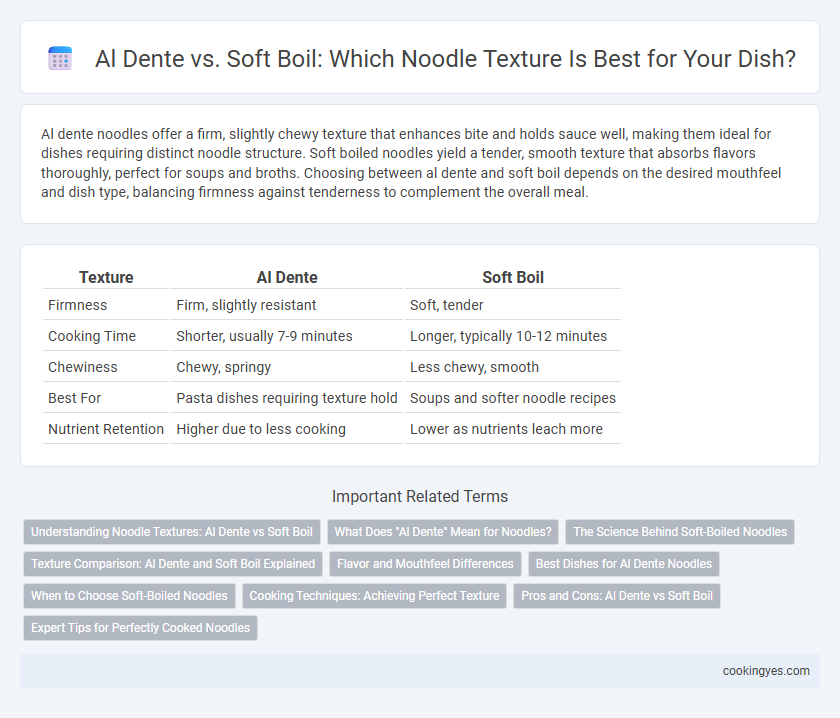Al dente noodles offer a firm, slightly chewy texture that enhances bite and holds sauce well, making them ideal for dishes requiring distinct noodle structure. Soft boiled noodles yield a tender, smooth texture that absorbs flavors thoroughly, perfect for soups and broths. Choosing between al dente and soft boil depends on the desired mouthfeel and dish type, balancing firmness against tenderness to complement the overall meal.
Table of Comparison
| Texture | Al Dente | Soft Boil |
|---|---|---|
| Firmness | Firm, slightly resistant | Soft, tender |
| Cooking Time | Shorter, usually 7-9 minutes | Longer, typically 10-12 minutes |
| Chewiness | Chewy, springy | Less chewy, smooth |
| Best For | Pasta dishes requiring texture hold | Soups and softer noodle recipes |
| Nutrient Retention | Higher due to less cooking | Lower as nutrients leach more |
Understanding Noodle Textures: Al Dente vs Soft Boil
Al dente noodles are cooked to retain a firm, slightly chewy texture, providing a satisfying bite that holds up well in sauces and stir-fries. Soft boil noodles, on the other hand, are cooked longer to become tender and pliable, ideal for soups and dishes where a delicate, melt-in-the-mouth consistency is preferred. Mastering the difference between al dente and soft boil textures enhances the culinary experience by matching noodle firmness to the specific recipe and desired mouthfeel.
What Does "Al Dente" Mean for Noodles?
Al dente" for noodles means cooking them until they are firm to the bite, preserving a slightly chewy texture that enhances flavor and mouthfeel. This texture contrasts with soft boil noodles, which are fully cooked and more tender, often resulting in a less structured bite. Cooking noodles al dente helps retain their shape and prevents them from becoming mushy, making them ideal for dishes that require a firm noodle consistency.
The Science Behind Soft-Boiled Noodles
Soft-boiled noodles achieve their tender texture through the breakdown of starch granules and partial gelatinization, which allows water to penetrate the noodle more thoroughly, resulting in a softer bite compared to al dente noodles. The temperature and duration of boiling influence the degree of starch gelatinization and protein denaturation in wheat-based noodles, with prolonged boiling times causing more extensive swelling and weakening of gluten networks. This scientific interplay between heat, water absorption, and molecular changes dictates the contrasting textures between soft-boiled and al dente noodles.
Texture Comparison: Al Dente and Soft Boil Explained
Al dente noodles offer a firm, slightly chewy bite that retains structure and enhances sauce adhesion, preferred in Italian cuisine for balanced texture. Soft boil noodles exhibit a tender, smooth consistency that melts in the mouth, providing comfort and ease of digestion, often favored in Asian dishes. Texture comparison highlights al dente's resilience versus soft boil's softness, influencing culinary application and sensory experience.
Flavor and Mouthfeel Differences
Al dente noodles offer a firm, slightly chewy texture that enhances the release of starches, intensifying the noodle's natural flavor and providing a satisfying bite. Soft boil noodles, in contrast, yield a tender and smooth texture that absorbs sauces more thoroughly, resulting in a richer, creamier mouthfeel. The choice between al dente and soft boil significantly influences the overall dining experience by balancing firmness and flavor release with softness and sauciness.
Best Dishes for Al Dente Noodles
Al dente noodles maintain a firm texture that enhances dishes like classic Italian pasta, stir-fries, and cold noodle salads by providing a satisfying bite that balances well with rich sauces or vibrant dressings. This cooking style preserves the noodle's structure, making it ideal for recipes that require tossing or multiple ingredients without becoming mushy. Soft boil noodles, while tender, work better in soups and broths where a smoother, softer texture absorbs flavors more readily.
When to Choose Soft-Boiled Noodles
Soft-boiled noodles are ideal for dishes requiring a tender, easily chewable texture, such as noodle soups and comfort foods where the broth's flavor dominates. This cooking style allows noodles to absorb more liquid, enhancing richness and melding well with delicate or creamy sauces. Opt for soft-boiled noodles when the recipe demands a smooth mouthfeel over firmness, providing a soothing, less resistant bite.
Cooking Techniques: Achieving Perfect Texture
Cooking techniques for noodles involve precise timing and temperature control to achieve the desired texture, whether al dente or soft boil. Al dente noodles are cooked just until tender but still firm to the bite, typically boiled for 1-2 minutes less than the package instructions, then immediately drained and sometimes rinsed with cold water to halt cooking. Soft boiled noodles require longer cooking, allowing the starches to fully gelatinize, resulting in a tender, slightly chewy texture ideal for soups and broths.
Pros and Cons: Al Dente vs Soft Boil
Al dente noodles offer a firm texture that enhances the bite and holds sauces well, making them ideal for flavorful, textured dishes; however, they require precise timing to avoid undercooking. Soft boil noodles provide a tender, easy-to-chew consistency that suits soups and mild dishes, but they can become mushy and lose structure if overcooked. Choosing between al dente and soft boil depends on the desired mouthfeel and dish type, with al dente favoring robustness and soft boil favoring softness.
Expert Tips for Perfectly Cooked Noodles
Achieving the ideal noodle texture hinges on precise timing and water temperature control; cooking noodles al dente preserves a firm bite with a slight chewiness, while a soft boil results in a tender, fully cooked noodle. Expert tips recommend boiling noodles in heavily salted water and frequently tasting to prevent overcooking, ensuring texture aligns with the dish's desired mouthfeel and sauce absorption. Using rapid draining and immediate rinsing with cold water can halt the cooking process, maintaining optimal noodles for dishes requiring precise texture, such as pasta salads or stir-fries.
Al dente vs soft boil for noodle texture Infographic

 cookingyes.com
cookingyes.com